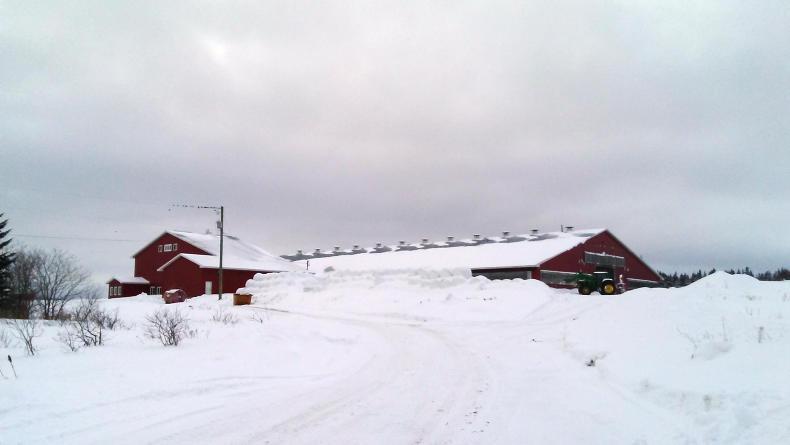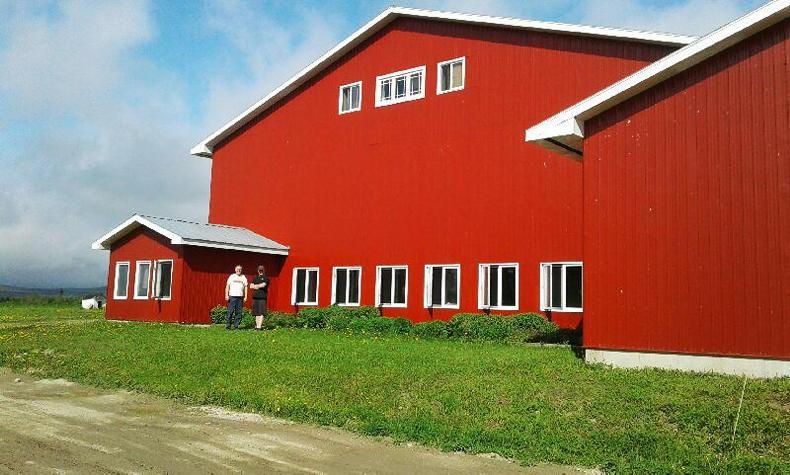We run a 980-acre dairy and crop farm at Cormack, on Newfoundland, which is an island off the east coast of Canada.
Newfoundland is 405,212sq km in size, which makes it the 16th largest island in the world. Ireland is the 20th largest island.
The farm is owned by Jane Duivenvoorden, my father Ron and myself, Noah Burnett, and our animals are kept indoors year round in a free stall barn.
Newfoundland has a very short growing season, around 90 days from June to the end of August with summer temperatures reaching a high of 20 to 25°C and winter temperatures falling to minus 20°C and as low as minus 30°C.

Newfoundland has a very short growing season, around 90 days from June to the end of August, with summer temperatures reaching a high of 20 to 25°C and winter temperatures falling to minus 20°C and as low as minus 30°C.
I am 17 and I’m just finishing high school so at the moment my main tasks are regular chores on the farm and fieldwork. I will be attending dairy college in the fall. Jane is the herdswoman and does all the AI on the farm. She was a large animal vet before she switched to farming so she does own surgeries when required.
Jane also looks after ration feeding and milking, alongside Maggie, a loyal employee of 17 years. Maggie works mainly on the milking and calving operations.
My father Ron looks after the field work and equipment repairs, as well as assisting with ration feeding and any necessary barn work.
The population of Newfoundland is about 500,000 people and we are a 178km ferry ride from mainland Canada.
About 60% of our farm is suitable for agriculture, with some of the land still being cleared of trees.

Noah (17) is in high school and will attend dairy college in the fall.
There are only 26 dairy producers on the island, making for a tightly-knit community and also leaving room for expansion. Newfoundland also has the largest average herd size in Canada.
Here in Cormack, we are currently milking 100 Holsteins in a double-eight herringbone parlour. We milk twice a day.
Our milk price right now is $1.14/l (€0.77/l), based on 4.1% butterfat. That is before transportation costs and milk board fees are removed. It’s a good price but with Newfoundland’s population being only 500,000, we produce more than is consumed on the island so we have to find other ways to process our milk.
Shipping milk to the mainland
The majority of our milk is processed in St John’s, the capital of Newfoundland, while excess milk must be shipped to mainland Canada which costs us more in transportation.
Our entire herd extends to around 250 animals, as we raise all of our calves and heifers on the farm. Our finished cattle will be shipped to either Quebec, Canada, or Pennsylvania of the United States. The stronger of the animals go to the US. Our price right now is around $1.60/lb liveweight, which is really strong.
Our ration contains a mix of corn, distillers, soya, premix, and fat. Our grains must be shipped in from mainland Canada because Newfoundland’s climate doesn’t allow us to grow our own grains.
We are now in our busy season when field work is the top priority.
We grow timothy, oats and peas.
Farmer Writes: farmer death rate 20 times higher than average in South Africa
Farmer Writes: exiting livestock in Australia's 13m tonne grain state
Watch: Farmer Writes – following the harvest across America
We run a 980-acre dairy and crop farm at Cormack, on Newfoundland, which is an island off the east coast of Canada.
Newfoundland is 405,212sq km in size, which makes it the 16th largest island in the world. Ireland is the 20th largest island.
The farm is owned by Jane Duivenvoorden, my father Ron and myself, Noah Burnett, and our animals are kept indoors year round in a free stall barn.
Newfoundland has a very short growing season, around 90 days from June to the end of August with summer temperatures reaching a high of 20 to 25°C and winter temperatures falling to minus 20°C and as low as minus 30°C.

Newfoundland has a very short growing season, around 90 days from June to the end of August, with summer temperatures reaching a high of 20 to 25°C and winter temperatures falling to minus 20°C and as low as minus 30°C.
I am 17 and I’m just finishing high school so at the moment my main tasks are regular chores on the farm and fieldwork. I will be attending dairy college in the fall. Jane is the herdswoman and does all the AI on the farm. She was a large animal vet before she switched to farming so she does own surgeries when required.
Jane also looks after ration feeding and milking, alongside Maggie, a loyal employee of 17 years. Maggie works mainly on the milking and calving operations.
My father Ron looks after the field work and equipment repairs, as well as assisting with ration feeding and any necessary barn work.
The population of Newfoundland is about 500,000 people and we are a 178km ferry ride from mainland Canada.
About 60% of our farm is suitable for agriculture, with some of the land still being cleared of trees.

Noah (17) is in high school and will attend dairy college in the fall.
There are only 26 dairy producers on the island, making for a tightly-knit community and also leaving room for expansion. Newfoundland also has the largest average herd size in Canada.
Here in Cormack, we are currently milking 100 Holsteins in a double-eight herringbone parlour. We milk twice a day.
Our milk price right now is $1.14/l (€0.77/l), based on 4.1% butterfat. That is before transportation costs and milk board fees are removed. It’s a good price but with Newfoundland’s population being only 500,000, we produce more than is consumed on the island so we have to find other ways to process our milk.
Shipping milk to the mainland
The majority of our milk is processed in St John’s, the capital of Newfoundland, while excess milk must be shipped to mainland Canada which costs us more in transportation.
Our entire herd extends to around 250 animals, as we raise all of our calves and heifers on the farm. Our finished cattle will be shipped to either Quebec, Canada, or Pennsylvania of the United States. The stronger of the animals go to the US. Our price right now is around $1.60/lb liveweight, which is really strong.
Our ration contains a mix of corn, distillers, soya, premix, and fat. Our grains must be shipped in from mainland Canada because Newfoundland’s climate doesn’t allow us to grow our own grains.
We are now in our busy season when field work is the top priority.
We grow timothy, oats and peas.
Farmer Writes: farmer death rate 20 times higher than average in South Africa
Farmer Writes: exiting livestock in Australia's 13m tonne grain state
Watch: Farmer Writes – following the harvest across America








 This is a subscriber-only article
This is a subscriber-only article





SHARING OPTIONS: